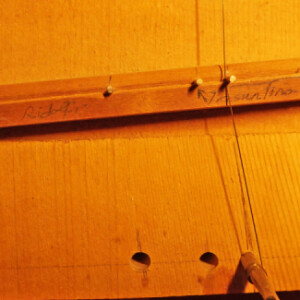The Monochord. Lumix M4/3 14mm
I can report that the last vestiges of my old harpsichord workshop, long in storage, were laid to rest this week. No more 50-mile round trips to retrieve stuff, and no more rent.
One of the last boxes to come back to the city, was labelled, unsurprisingly, Harpsichord Supplies. It contained my stringing stock, and this quickly-cobbled-together device called a monochord. It was used to determine empirically that the strings in the middle and treble of the harpsichord's range could be brought up to the desired pitch without exceeding the tensile strength of the string wire.
When the old harpsichord makers built their instruments during the 16th through 18th Centuries, they worked out a design by trial and error, and then stuck to it like grim death, lest they produce something which could not be matched to the pitch of other instruments.
As organologists have examined surviving harpsichords in musical instrument collections in Europe and the U.S., they have observed how the keyboard ranges, and sometimes the bridge positions on old instruments have been altered to accommodate changing pitch levels over the centuries. It was comparatively recent - the 1930s - that it was agreed that orchestral woodwinds would be made to a standard: the "A" above Middle C would be 440 Hertz, a measurable and consistent pitch. In previous centuries, a' has been as low as 392 Hertz, a full tone below 440, and as high as 460 Hertz.
For a harpsichord maker endevouring to produce a copy of a museum instrument, it is essential to know that what one is reproducing will result in a viable harpsichord, playable with other instruments at a standard pitch consensus. For the Baroque period, this is considered to be a'=415 Hz, or a semi-tone below a'=440Hz - modern orchestral concert pitch. This is all very confusing, hence the monochord.
The Extra shows that the nut is marked with the ruling string length for each of the Italian-style harpsichords I offered to customers.
I think this rustic-looking device will receive some refinement, some finishing touches, and find a place on the wall of my little workshop, as a memento of a previous professional life.


Comments
Sign in or get an account to comment.


